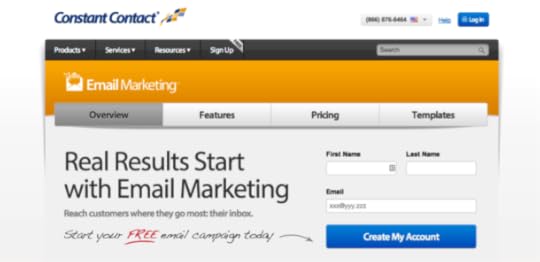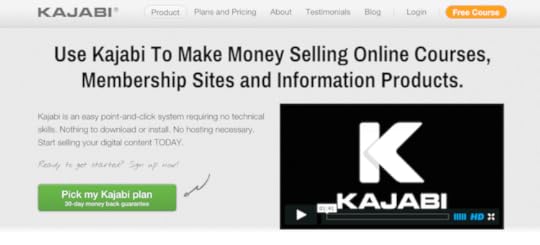Marcu Taylor's Blog, page 26
December 21, 2015
9 Best Email Marketing Software Tools & Services
As a digital agency, we’ve used a lot of email marketing tools over the years. In this post we want to share with you our experience with the following services.
Best beginner email marketing toolsBest advanced email marketing tools
Service
Pricing*
Ease of use
Email templates
Free trial?

$25 /mo
4/5
5/5
30 days
Go to Website

$29 /mo
5/5
3/5
14 days
Go to Website

$35 /mo
4/5
3/5
2,000 contacts
Go to Website

$49 /mo
4/5
4/5
No
Go to Website

$49 /mo
2/5
3/5
500 contacts
Go to Website

$55 /mo
3/5
3/5
60 days
Go to Website
* Pricing is based on 2,500 subscribers.
Service
Pricing*
Automation
Reporting
Free trial?
$65 /mo
Basic
4/5
30 days
Go to Website
$70 /mo
Yes
3/5
14 days
Go to Website
$149 /mo
Yes
4/5
21 days
Go to Website
$297 /mo
Yes
4/5
No
Go to Website
$379 /mo
Yes
5/5
No
Go to Website
* Pricing is based on 10,000 subscribers.
It’s become clear to me that there’s no one-size fits all solution when it comes to email marketing software. The best tool for you completely depends on what you’re looking to get out of your email marketing.
If, for example, you just need a tool to send out newsletters, GetResponse might be ideal. On the other hand, if you need a service that sends behaviour triggered emails to customers, Infusionsoft may be a better fit. Finding the right email marketing software all depends on what you’re looking for.
In this post, I’ve written a detailed review of six of the most popular email marketing services. For a quick summary and pricing comparison, I’ve created the following table.
Email marketing software reviews
Below, I’ve reviewed each of the email marketing tools mentioned above in great detail. Admittedly, every solution has both upsides and downsides. I’ve tried to keep each review as neutral as possible, highlighting both the good and the bad.
GetResponse
GetResponse are an exceptional underdog in the email marketing space. In my opinion, they’ve built the best email marketing service for small to medium sized businesses.
While they may not have the legacy of Aweber, or the strong brand of Mailchimp, they probably have the best overall service.
There are a few things that I really like about GetResponse.
First of all, their newsletter designs look beautiful and are leaps and bounds beyond their competitors. They offer over 500 professionally designed newsletter templates to choose from, all of which are mobile-optimised straight off the shelf.
Secondly, their autoresponders and automation tools are amazing. While not nearly as powerful as dedicated marketing automation services like Infusionsoft, you can easily automate email campaigns based on whether subscribers buy a certain product on your website or sign up through a certain form.
Considering that GetResponse costs a fraction of what most marketing automation services charge, this is a huge bonus that I wasn’t expecting when I signed up for GetResponse.
Next up, GetResponse have extremely intuitive A/B testing functionality. By default, you can A/B test subject lines, email content, sending times, and the from field. This feature alone has enabled me to double my email engagement rates.
GetResponse has a good API, making it easy to integrate it with plugins and other software platforms. We use the official GetResponse WordPress plugin to capture email addresses from our contact form and comments, as well as integrating it with our CRM system and reporting software.
One final feature worth mentioning is time travel.
Time travel enables you to set a universal time that your email campaign arrives in your recipient’s inboxes. In other words, you can schedule an email that arrives at 9am, regardless of whether the recipient is in London, Moscow, or Tokyo.

This is a life-saver if you have people from all over the World on your mailing list. Gone are the days where your email campaigns arriving at 2am in the morning!
There are a few things that I’m not particularly fond of with GetResponse. Firstly, their user dashboard is not as intuitive as it could be. While I’m used to it now, it did take a while having to Google “How to delete lists from GetResponse”, before I understood where everything was.
I also find their form builder quite difficult to use. Again, it’s fine once you get used to it, but initially it gave me a few headaches. That said, no email marketing service is perfect and out of the lot of them GetResponse is definitely my favourite.
In terms of cost, GetResponse are one of the most affordable email marketing services. Their pricing starts at $15/month and includes a 30-day free trial. This makes GetResponse more affordable than both Mailchimp and Aweber’s starter package.
Overall, GetResponse has my vote. If you want to give them a shot, you can sign up for a free trial here.
Sendy
If you’re after a ‘no frills’ email marketing tool, you may like Sendy.
After stumbling across Sendy on Twitter last year, I decided to give them a shot. I ended up using them for about six months before finally deciding to migrate all of Venture Harbour’s mailing lists to GetResponse.
For me, the main attraction to Sendy was the affordability and simplicity. Sendy is by far the most cost effective email marketing service, as they use Amazon SES (Simple Email Service) to send emails, which costs about $1 per 10,000 emails.
The main advantage with Sendy is that it’s a self-hosted tool. In other words, you have to install it on your website’s server and setup a subdomain like ‘email.yourdomain.com’. Here you will upload the installation files that you download from the Sendy website.
Thankfully, Sendy provides a detailed setup guide on how to do this. Their setup guide gives you easy to follow instructions on how to upload the files and connect your site to Amazon SES.
I’m not particularly technical, and I managed to get it up and running in about 25 minutes.
Another benefit with Sendy is that it’s easy to white label. This makes it a great choice for agencies or web design companies wishing to provide clients with an email marketing platform. You can also set the price your clients pay per email, so that you can earn a profit from your client’s email marketing, if you wish to do so.
One of the other key benefits of using Sendy is that you don’t have to mess around with double or even single opt-ins.
Because it uses Amazon SES to send emails, you have a lot of control over adding people to your list. Ideally, your subscribers should always opt-in, but sometimes this isn’t possible and other services like Mailchimp make this quite difficult.
The user interface on Sendy is extremely basic, but has everything you need for basic email marketing e.g. reporting, a campaign builder, and contact lists. Here’s a screenshot of the Sendy campaign builder:

The reporting dashboard is refreshingly to the point. While very limited, it contains everything you’d need to know to analyse the performance of a basic email marketing campaign:

All in all, Sendy is a good choice for sporadic email marketers who don’t need any bells and whistles. There is a one-off fee to license the software ($59), but after you’ve paid this it only costs $1 to send 10,000 emails.
For Venture Harbour, we ended up moving to GetResponse quite soon after trying Sendy. The main reason was that, for the type of email marketing we do, features like automation and A/B testing is extremely important. For us, Sendy was way too limited.
That said, if you’re after a self-hosted email marketing service, or a cheap way to send a large amount of emails, it’s definitely worth considering.
Aweber
If for whatever reason you’re not impressed by GetResponse, I’d recommend looking into Aweber.
Despite looking a bit outdated, Aweber sits in a sweet spot of being cost effective and easy to use. It has all the important features you’d want, without being too feature heavy.
For those starting out, it has great reporting to help you learn what does and doesn’t work. Their email campaign creator is great at walking you through how to setup your signup forms and newsletters.
If you’re more advanced in your email marketing, Aweber has some good features, such as split testing. Split testing enables you to send different variations of a campaign to different segments of your list. This allows you to compare and improve your open and engagement rates.
They also offer auto responders, RSS-to-email, and a ton of third-party integrations. Perhaps their most useful integration is with WordPress. Their WordPress plugin enables you to add email signup forms to your website in a single click.
The thing that I love about Aweber is that it’s so simple, yet still has everything you need to get the job done.
I’ve switched between Aweber and Mailchimp for some of my own projects several times. Despite Mailchimp’s slick design, I find the functionality and reporting of Aweber much better.
With Aweber, you’re not locked into any long-term contracts. Their pricing starts at $19/month, and allows you to send unlimited emails to up to 500 subscribers.
Aweber is a bit more expensive than GetResponse. Although only by $4/month, so it’s really a matter of preference.
Mailchimp
For years, I used Mailchimp to manage the email marketing for TheMusiciansGuide.co.uk, a site I ran with about 12,000 email subscribers. As Mailchimp got bigger, they introduced a lot of features that, in my opinion, have made it quite difficult to use for serious email marketing.

The major downside with Mailchimp is that subscribers must double opt-in. You can, of course, import subscribers without them having to opt-in. For anyone new, though, Mailchimp forces them to opt-in via both a web form and confirmation email.
This meant I was losing about 15% of subscribers who were signing up on the website but not confirming their email address.
The other thing that is not so great about Mailchimp is the homogenisation of their email templates. Because so many marketers use Mailchimp, their newsletter templates look familiar. While you can customise these, they somehow always have that Mailchimp newsletter look!
One thing that I think Mailchimp do particularly well is their API. Their integration capabilities with other services is quite extensive. Whether you want to connect Mailchimp to WordPress, your CRM system, or proposal software, there’s a lot of support to do so.
If having a good API is important, then Mailchimp may be worth consideration.
The general functionality with Mailchimp is fine. Their user interface, reporting, and campaign manager is intuitive and easy to get the hang of. Mailchimp also offer two different pricing structures; pay as you go, and a monthly subscription.
This can be particularly useful if your email marketing is sporadic. When I used to run The Musician’s Guide, I’d often take a break from sending newsletters for months at a time. While more expensive per email, the pay as you go option saved a lot of money over the long run.

At $0.03 per email, that’s over 300x more expensive than Sendy.co.
InfusionSoft
InfusionSoft is an interesting option.
In some ways it’s wrong to compare it with services like Aweber and GetResponse, as it’s not just an email marketing tool. Infusionsoft is a full sales and marketing automation tool. Email marketing is just one of the many tools provided.
That said, it’d be naive to not feature Infusionsoft in this post. For many businesses, their platform is a complete game changer.
So let’s acknowledge the elephant in the room; InfusionSoft is expensive. Their pricing starts at $199/month, plus you have to pay for a kick-starter package that costs $1,999.
For most marketers and business owners, this is way out of budget. For some, though, this is a fraction of the return that Infusionsoft generates for their business.
InfusionSoft is a full CRM system, with marketing automation and eCommerce tools. So what can you do with InfusionSoft that you can’t do with other tools reviewed here?
In short, you can automate your sales and marketing based on customer behaviour.

I was speaking to a friend recently who was telling me that his company created a virtual sales person on Infusionsoft. Bruce, as they named him, keeps in contact with thousands of customers for them. He checks in every few weeks with different messages depending on what each customer has or hasn’t done.
For example, if someone adds a product to their shopping cart but doesn’t checkout, an email can be triggered reminding them to complete their order.
Perhaps you want to automatically send discount coupons to customers on their birthday? Or, maybe you want to create funnels that turn your non-paying subscribers into customers. With Infusionsoft this is all possible.
It’s a complex tool that’s as powerful as it is addictive. The biggest complain I hear from Infusionsoft customers is that you can spend days creating sequences!
If you’re interested in learning more, we’ve written a more in-depth review of Infusionsoft here. In general, Infusionsoft only becomes a good investment when you’re turning over at least $150k per year. It also only really makes sense if your business revolves around selling products online.
If you’re just starting out with email marketing, InfusionSoft is almost definitely not the right fit.
Constant Contact
I’ve never been a fan of Constant Contact, as I find their user interface a bit dated, and their overall service very mediocre. That said, it’s been 3-4 years since I’ve used their service on a client and it does appear that they’ve picked their game up somewhat.
Constant Contact’s selling point used to be that they were the most cost effective solution. Many of our clients used them because they were free (in return for including a Constant Contact logo at the bottom of every email).
It seems that’s changed, as their prices are now quite expensive relative to some of the other options.
Constant Contact charge $50/month for 2,501-5,000 subscribers. To put this into perspective, GetResponse only costs $25-$45 for this amount of subscribers.
In my opinion, Aweber and GetResponse both have better integration capabilities, reporting, and templates. So, it’s hard to understand how Constant Contact are justifying their extra cost.
That said, Constant Contact do have a few interesting features worth mentioning. First of all, they offer every customer a personal marketing coach to assist with any questions or problems you have.
For first timers, email newsletters and auto responders can be quite a challenge to set up, so I can see how this is quite a valuable feature.
Constant Contact appear to be creating a one-stop shop for marketers. With event registration tools, feedback forms, and surveys, it looks like they’re branching out.
This is a brave move, considering that there are excellent free tools like Eventbrite and Survey Monkey.
In general, I find Constant Contact’s offering just a bit too dull. There’s no clear USP or compelling reason why I’d use them over competing services.
In Summary
There are dozens of email marketing services out there. The six we’ve reviewed are just what I consider to be the main contenders for small to medium sized businesses.
I don’t believe that there’s a one size fits all solution when it comes to email marketing, so you need to weigh up your requirements.
The cheapest email marketing software
The cheapest option for email marketing is without a doubt, Sendy.co. Sendy is approximately 100x cheaper per email than the other services reviewed here. It’s by far the most cost-effective way to send bulk email. The only considerations are that it needs to be installed on your web server, and the functionality is very basic.
The best email marketing software for entrepreneurs & small businesses
For most entrepreneurs and small businesses, I’d recommend GetResponse.
For businesses that need a full email marketing automation system, I’d recommend InfusionSoft. It’s certainly not the most affordable option, but for a good reason. The automation capabilities can save you days of repetitive work while lifting your conversions.
Generally, if you’re still undecided, I’d recommend giving GetResponse a shot. If you’re looking for something basic and are technically savvy (and have access to your server), then Sendy is worth a look at. If you run an eCommerce website that turns over at least $150k, then Infusionsoft may be worth the investment.
I hope that’s helped – if you have any questions then feel free to post in the comments below, or contact us here.
Image Credit: Johnny Hughes
The post 9 Best Email Marketing Software Tools & Services appeared first on Venture Harbour.
January 23, 2015
10 Best Practices When Collecting & Displaying Product Reviews
Countless studies have shown that more reviews equal more revenue. One popular study by iPerceptions found that customers are 63% more likely to buy from sites that display customer reviews.
Reevoo also found that displaying product reviews increased online sales by an average of 18%. In reality, the specific percentages are quite arbitrary – all you need to know is that the presence of reviews, and how you present them, can have a significant impact on your website’s bottom line.

Best Practice for Displaying Reviews
1. Let customers determine the order of reviews displayed
It makes sense that not all reviews are created equal and that some will have a larger impact on convincing potential customers to buy the product than others. When Amazon realised this, they added a single question that said “Was this review helpful to you?”, which sorts reviews from most to least helpful. By using this question to ‘self sort’ reviews and display the most helpful ones first, Amazon’s revenue increased by $2.7 billion.

2. Split reviews into different categories
While aggregate reviews are useful to get an overview of a product’s quality, it’s useful for customers to see a breakdown of what previous customers liked and disliked about the product.
As you can see in the example below, in this review of Plus500 users are asked to rate the service in three categories; customer support, tools & features, and fees. As some customers are more sensitive to some of these categories than others, it helps customers see whether the product is likely to be a good fit for them.

As every business is different, you’ll want to experiment with which categories to display. If possible, the more product specific your categories can be, the better. For example, if you can display ‘battery life’ on mobile phone products, but ‘start up speed’ on laptop products, I’d predict that this would boost your product page conversion rates.
3. Markup your reviews for rich snippets
By marking up your product page’s reviews with Schema.org markup, you’ll likely notice an increased click through rate of your product page’s search traffic, resulting in more SEO traffic to your site.

The quality of this traffic is also likely to be very high, as people searching for ‘[product name] reviews’ are likely to be near the point of buying the product. If they land on your site, and the reviews are convincing, they may well buy from you.
4. Ensure your reviews are displayed in the code
One of the great side benefits of having customer reviews is that they make it easier to rank for long-tail search phrases that customers write in their reviews. This is only the case, however, if search engines can actually read your customers’ reviews.
Ensure that the review system you’re using displays reviews in plain HTML, instead of rendering them with Javascript, Flash, or other languages that are typically not readable for search engines.
5. Encourage customers to write detailed reviews
Generally speaking, the longer and more segmented reviews are, the more useful and influential they will be for potential customers.
While it’s important to not over-complicate your review forms, you can nudge customers to write longer reviews by having a minimum word count, and adding extra fields to capture more information from them.

6. Display negative reviews, providing they’re authentic
Negative reviews have been found to increase conversions for two reasons. First of all, customers are more likely to trust a site that displays negative reviews, and as such it lends more credibility to the positive reviews.
Secondly, if a product has negative reviews the customer is likely to consider buying a different product on the same site. Providing you’re agnostic over which specific products your visitors purchase, showing negative reviews has a positive impact on conversion rates.
That said, too many negative reviews is obviously harmful. In an experiment by Lightspeed Research, they found that three or more negative reviews on a product had a significant impact on influencing the visitor to change their mind.
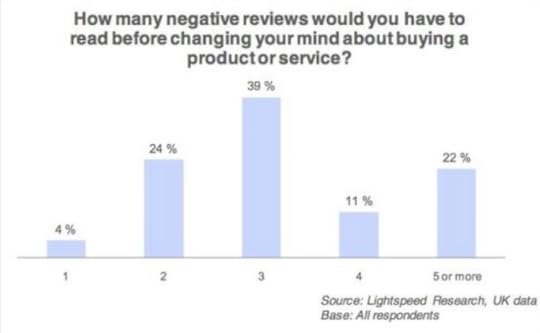
7. Experiment with the layout and design of your review section
There is no right or wrong way to display reviews. There are, however, some designs that are better than others in displaying information that encourages potential customers to buy the product they’re interested in.
You should constantly be running split tests on your review section and researching new ways to improve the level of information that they provide.
Best Practice for Collecting Reviews
8. Setup post-purchase email reminders
The best time to ask for reviews from customers is shortly after they’ve received the product, when they’re still in the ‘honeymoon period’. The best way to do this is by automating an email that encourages them to leave a review using your marketing automation software or transactional email service.
The specific timing of when to ask for a review will vary from product to product, so it’s worth running some split tests to see which duration results in the highest number of reviews left.
9. Incentivise customers to review products
I remember being told that the average response rate for non-incentivised review requests is around 0.1%, which means that for every review you read on Amazon, there’s around 999 customers who haven’t left a review.
One way to significantly increase the rate of reviews left is by offering an incentive. This might be entry into a competition, a discount coupon, or even a free upgrade.

10. Ask for reviews personally
While this can take a lot of work, it’s worthwhile asking for reviews directly from loyal customers, or encouraging your customer service team to do so, in a personal manor.
Just a few days ago I received this email from GetResponse, after writing my thoughts on their service. Sure enough, when I’ve done this kind of personalised outreach in the past the response rates have been relatively high.

In Summary
When it comes to collecting and displaying product reviews it’s important to keep an open mind and continually question and experiment with what works.
We’ve only just scratched the surface in this post, so if you have any other recommendations or experiences worth sharing, please leave them in the comments below.
The post 10 Best Practices When Collecting & Displaying Product Reviews appeared first on Venture Harbour.
January 19, 2015
10 Tips For Luxury Brands to Embrace Digital Marketing
In 2014, McKinsey published a report suggesting that digital now influences at least 45% of all luxury sales.
It’s understandable why luxury brands have been hesitant to move online. Yet, with print and display advertising returns decreasing, and luxury shoppers spending more time online and on mobile devices, luxury brands need to not only adapt to survive in the digital universe, but to thrive also.
Having created our own luxury online platform (Qosy) at Venture Harbour, which has led to helping luxury brands such as Johnnie Walker, McLaren, and Marriott with their digital presence, I’ve learnt a lot over the past twelve months around the do’s and don’ts of luxury online marketing.
In this post, I want to touch on 10 tips and lessons to help luxury brands use digital marketing effectively.
1. Take advantage of visual social networks
When marketing luxury products, photographs are one of the best mediums for evoking the aspirational emotions that we connect with driving a luxury vehicle, wearing designer clothing, or experiencing something exclusive.
As such, visual social networks like Pinterest represent a huge opportunity for luxury brands to raise brand awareness and advocacy.
In fact, Chanel are one of the most ‘pinned’ brands on the social network, with over 1,244 pins of Chanel products pinned on the social network per day on average. This is made even more impressive when you consider that Chanel do not even have an account on Pinterest (it’s all driven by their advocates).

A luxury brand that I came across who do an exceptional job of marketing themselves on Pinterest is 77 Diamonds in London. Their Pinterest profile is aspirational, educational, and strikes a great balance between not being too promotional, yet still raising awareness of 77 Diamond’s products.

2. Build a website that combines style, user experience, and functionality
Generally speaking, luxury brand websites are very stylish, but perform poorly when it comes to user experience and functionality.
Take Dom Perignon’s website for example. Once you’ve completed a non-essential age verification page, you enter a slow loading flash site that takes about 13 seconds on a high-speed Internet connection to load.
If you’re still around, you reach a website that’s very difficult and confusing to navigate.

The Chanel website is very similar in that, while the colours and visuals are nice, the design is so unintuitive that it’s almost impossible to find what you’re looking for, let alone buy anything.

While I appreciate the need for stylistic design, luxury brands need to invest in websites that are also intuitive and well desgined from a user experience perspective.
Aston Martin and Versace are both great examples of what luxury brands should be doing with their websites. Their websites are visually stunning, while very easy to use, and highly functional.
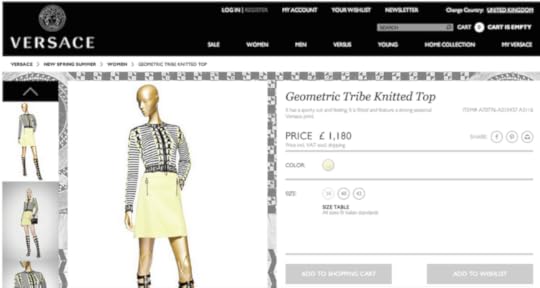
3. Use brand heritage to tell the stories behind products
In his book ‘Start With Why’, Simon Sinek explains how great marketing starts by explaining why they exist. Despite this, the majority of brands still market their products by explaining what they do.
Take Apple for example. Here’s a paraphrased excerpt of how apple communicate with their customers:
“Everything we do, we believe in challenging the status quo. We believe in thinking differently (why Apple exists). The way we challenge the status quo is by making our products beautifully designed, simple to use and user friendly (How Apple achieve their why). We just happen to make great computers (What Apple do).”
Communicating the story behind your products, and explaining the values that define a luxury brand, is fundamental to effective luxury marketing.
Aston Martin do a great job telling the story of their brand heritage on all of their product pages and digital content.

By explaining that your brand represents an assurance of luxury, quality, performance, style, or whatever value you stand by, you will find it easier generating advocacy for your brand online.
4. Use Facebook Ads to reach luxury shoppers
Facebook Ads are one of the most effective forms of online advertising, thanks to the high level of segmentation and targeting that you can do.
You could, for example, target ads specifically to married 35 year old males from Paris who like the brands Prada, Gucci, and Versace. You can even go one step further and target people by what college they attend, where they work, what their job title is, what music they listen to, and much much more.
Below are some examples of how luxury brands are using Facebook Ads:

5. Don’t underestimate the value of good SEO
Google is one of the most influential channels when it comes to helping luxury shoppers find products, learn more about brands, and make their purchase.
As we’ve already alluded to, most luxury brands have pretty poor websites. Unsurprisingly, most of those websites also have extremely bad SEO, making it difficult for their websites to rank well in Google for search terms that would otherwise capture potential customers.
Take Prada for instance. When I search for Prada handbags, not only do I not receive a link to Prada’s handbag page (due to their poor keyword targeting, slow site, and poor on-site structure), but the results also look messy and untargeted.

SEO is an untapped goldmine for luxury brands. If your site isn’t SEO-friendly, you’re likely to be leaving a lot of potential traffic and revenue on the table.
6. Create aspirational content to educate customers
One of the most effective ways we’ve found to generate traffic and engagement for Qosy is create highly visual and aspirational content, such as our guide to kitchen islands.

By focusing on long-form visual content, we’ve generated 10,000’s of social shares, and a huge amount of SEO traffic. While common in many other niches, content marketing is massively underused and enormously effective for luxury brands.
7. Supply content that appeals to people’s desire to display their status
In Jonah Berger’s book, Contagious, he explains that one of the main reasons why people talk about things, and spread word of mouth (online or offline) is to display the traits that they want others to see in them.
Charities, for example, are one of the most liked categorises of pages on Facebook. While some of this can be explained by altruism, it’s been found that the main driver for liking a charity on Facebook is to show others that you’re charitable.
Because one of the primary motivations for buying luxury goods is to display status, brands can take advantage of this by creating and publishing content that, when others share, will make them look stylish, smart, or cool to their friends.
We found this with Qosy when we created our guide to the best scotch. Within 48 hours of publishing the guide, over 4,000 people had shared it – many of whom were using the guide to show off their own scotch knowledge.

8. Create a sense of exclusivity online
Exclusivity is fundamental to luxury brand marketing as it maintains consumer desire through scarcity and rarity. If anyone could walk into Louis Vuitton and buy a handbag, Louis Vuitton would lose their appeal to those who wish to have something that others can’t get access to.
Given the Internet’s accessibility and autonomy, many luxury brands worry about losing their sense of exclusivity when it comes to going online. This, however, is flawed logic.
For luxury brands, the Internet does not represent wider distribution of actual products. It’s a wider distribution of the content that evokes the desire to buy luxury products.
Translated to the offline world, effective digital marketing is like running more advertisements on buses, or more TV ads, or having more stores in Central London.
Exclusivity can be created online through private member groups, concierge services, or digitally-delivered loyalty perks that are reserved specifically for previous customers.
9. Never stop building your list
Email marketing is extremely effective for eCommerce marketing and increasing customer loyalty, as it provides the opportunity to educate consumers and tell them about new experiences or products offered by the brand.
Harrods do an exceptional job with their email marketing campaigns, and are well worth subscribing to for email campaign inspiration.

10. Take the in-store experience online, and the online experience in-store
In the near future, talking about online and offline will be like talking about the benefits of our left leg vs. our right leg. Both are integral to the other.
One luxury brand who are leading the way in combining the in-store and online experience is Burberry.

It seems that every few months Burberry are running a new online brand-awareness campaign, driving luxury shoppers into their stores. Once those customers are in the stores, they’re encouraged to take pictures, share content, watch live streams, and use in-store iPads.
The post 10 Tips For Luxury Brands to Embrace Digital Marketing appeared first on Venture Harbour.
January 15, 2015
How to Sell Online Training Courses With Kajabi, FusionHQ, or Udemy
The market for online courses has grown rapidly over the past few years, enabling anyone with an Internet connection to receive world-class knowledge for a small price.
This represents a huge opportunity for those willing to share their knowledge. Last year, 10 teachers on the online training platform Udemy earned over $1.6 million from selling online courses. Another teacher, who previously earned $30,000/year from teaching, now makes over $1 million selling lesson plans to other teachers online.
If you have specialised knowledge that others are willing to pay for, the only thing stopping you from creating an income source from selling online courses is creating your first video and finding the right platform to sell it on.
In this post I want to focus on which platforms are best for selling courses online, and look into each platform’s pros and cons.
While there are countless options to choose from, I’ve limited this post to four of the most popular and powerful options: Kajabi, FusionHQ, Udemy, and Academy of Mine. To kick off, we’ll look at Kajabi.
Kajabi
Kajabi is the most popular online platform for selling digital products online. Built by Kenny Rueter and Travis Rosser, who are both information marketers themselves, and used by some of the most renowned online instructors and information marketers, it’s got a strong track record.
So, how does Kajabi work?
Kajabi lets you create a customised private membership site or dashboard where your members can access your information products (videos, audio files, articles, templates, reports etc). To become a member of your site, they must pay you for access (usually a monthly subscription fee), which is all handled by Kajabi.
When you upload your files, they can be published to your members immediately, on a specific date, or drip fed over time so that new content is released every week, month, or at whatever interval you choose.
Kajabi also lets you set membership tier levels, so that different members can have access to different files. The platform allows you to set up a referral program, create landing pages, and use a range of proven templates to encourage people to sign up to your online course and engage with your content. There is also the ability to create an online community where members can talk to each other and comment on your content.
The whole platform is cloud-hosted, meaning you needn’t worry about anything technical (no installing files, finding web hosting or installing CDNs).
With a 30-day free trial and a $99 starting plan, Kajabi is one of the most affordable hosted online training platforms. For comparison, Academy of Mine starts at twice the price ($199/month), while FusionHQ starts at $147/month.
FusionHQ
FusionHQ was one of the first platforms built for selling information products online, including online training courses. While conceptually very similar to Kajabi, FusionHQ is less focused specifically on online courses, and has a lot more functionality around automating your marketing and sales funnels.
FusionHQ market themselves as being a complete online business platform that allows you to build an online business with everything you need in one place: split testing, email lists, affiliate programs, membership sites, landing pages etc.
Like Kajabi, it’s entirely hosted so you don’t need to worry about any of technical set up or infrastructure.
One of the main benefits of FusionHQ is that their user interface is beautiful and extremely easy to use. Everything is done in a drag and drop editor, so no coding knowledge is required.
Academy of Mine
Academy of Mine is designed specifically around selling online courses, and while it has many of the same features as Kajabi and FusionHQ, there are a handful of unique features dedicated to selling online courses.
For example, Academy of Mine allows you to live-stream classes, go into 1-to-1 chat with students, and do whiteboarding & screencasting with students. You can also create quizzes, exams, certificates and badges for students to earn as they complete different modules of your training course.
The reporting tools on Academy of Mine are very insightful, providing information on aggregate performance of courses, as well as individual student progress.
Starting at $199/month, Academy of Mine is relatively expensive, but being entirely targeted towards selling online courses, you’re really paying for the extra features that are designed specifically to help you market and sell your courses.
Udemy
About six months ago, I created a short free course on how to setup a WordPress website on Udemy, as I already had the material filmed and was interested to see how the platform worked.

Frankly, the experience wasn’t great. While their platform is very sleek and easy to use, and has over 22,000 courses, their approval process is a bit of a nightmare to deal with.
Not only was I receiving emails from about four separate staff members about getting my course ready to go live, but there were lots of hoops to jump through in terms of encoding the videos and editing the course’s description. While this is all totally understandable from a quality control perspective (and the second time you do it it’d likely take less time), it does make uploading your first course quite painstaking.
My experience aside, Udemy is one of the biggest marketplaces for buying and selling online courses, and with over 5 million students, you have your audience taken care of.
One thing that I did particularly like about Udemy was that they’re proactive in promoting your course. With no promotion from my end, Udemy have sent over 250 students to my course by featuring it every now and again.
In Summary
Which platform you choose to sell your online course on, you’ll be in good hands. While Kajabi generally works out to be the best value option, there are certain features that FusionHQ, Udemy, and Academy of Mine offer which can swing the needle in their favour.
If you’ve used one of these services in the past, I’d be intrigued to hear some previous customer’s experiences of any of these services (or any that are worth mentioning that aren’t mentioned here).
The post How to Sell Online Training Courses With Kajabi, FusionHQ, or Udemy appeared first on Venture Harbour.
January 14, 2015
My Experience With & Review of GetResponse
Just over a year ago, I moved all of our mailing lists at Venture Harbour from Aweber and Mailchimp over to GetResponse.
Since that move, our delivery rates have increase, as have our open rates (by 48%) and click through rates. I’ve also experimented with many of GetResponse’s innovative features, such as ‘time travel’ and automation, which I’ll talk about in more detail below.
In this post I want to share a few of the pros and cons of using GetResponse. While I do believe they are by far the best and most cost effective email marketing tool available, there are a few things about their service that are frustrating and are worth knowing before you become a customer.
Let’s start off with what GetResponse do well:
The Good
Pricing – Last year I wrote an in-depth comparison of the six major email marketing software companies. Of the six, GetResponse came out on top as the most affordable service at virtually all pricing tiers.
If, for example, you have 5,000 subscribers, GetResponse will cost $45/month (whereas for the same list size, Aweber would cost $49/month, Mailchimp would cost $55/month, and Constant Contact would cost $75/month).
On top of this, GetResponse have a free 30-day trial that doesn’t require a credit card.
Powerful Auto-responders & automation rules – One of my favourite features about GetResponse is the ability to set up autoresponders in a calendar view. Unlike other services that show autoresponders in a list, this makes it easy to see what emails are being sent throughout a given month.
On top of this, GetResponse have began adding automation features, that allow you to automate campaigns to be sent out when a subscriber clicks on a link, buys a product, or triggers a handful of other actions. While their automation offering is very limited in comparison to dedicated marketing automation tools like Ontraport, it’s an incredibly useful feature for the price (most automation tools cost $200-300/month alone).
A/B testing – Another feature that GetResponse do very will is enabling you to run A/B tests on subject lines, content, delivery times, sender names, and list segments. While most email marketing tools do enable A/B testing, most only allow you to split test the content and subject line.

As I’ve written about before, email A/B testing is so powerful that when Barack Obama ran an A/B test on two subject lines, he found that one subject line generated $403,600 in donations, whereas the other variation generated $2,540,866.
In short, if you’re not split testing your emails, you’re leaving money on the table.
Responsive email design & inbox previews – While this feature is becoming common across most email tools, GetResponse have been slightly ahead of the curve in making mobile newsletter templates, and allowing you to preview your message across multiple mobile devices and email clients.
Great reporting – While GetResponse’s at a glance reports aren’t anything too special, they make it easy to do side-by-side comparisons of campaigns, as well as letting you segment your campaigns to see which portions of your campaign worked better than others.

On top of this, you can track the social media impact of your emails, and email ROI by installing a tracking code on your website to see which emails have the greatest impact on driving conversions.
Deliverability – According to third-party deliverability review site, Return Path, GetResponse have a 99% email delivery rate. By nurturing relationships with ISPs and using automatic feedback loops to improve list hygiene, GetResponse have become one of the best email marketing services for achieving high deliverability rates.
Time Travel – This is an extremely useful feature that enables you to set a specific time that your campaign arrives in the inbox of subscribers, regardless of their time zone. For example, if you set your campaign to go out at 9am, it’ll be sent to your subscribers in London and Tokyo at 9am their time.
This is a huge time saver, as it prevents having to either segment your list into lots of different country buckets, or having to send out your message to a portion of your audience at sub-optimal times.
The Bad
Email builder is clunky – One of my biggest gripes with GetResponse is the clunkiness of their drag and drop email builder. While there’s no specific issue, the interface is generally unintuitive and I often struggle to do simple things that shouldn’t require any though, such as correctly aligning content sections, and inserting images.
Hard to segment list by location – One feature that I love about Mailchimp is the ability to automatically collect a subscriber’s location based on their IP address and then segment email campaigns to specific users based on that criteria.
While GetResponse do collect IP information, I’ve never figured out how to segment an email campaign based on location without having to explicitly ask the subscriber to enter their location in an email capture form.
Automation is limited – While GetResponse’s automation features are very powerful for the price, they’re quite limited in terms of functionality. Currently there are only about seven rules that you can use to automate actions.
On top of this, their automation rules only allow you to automate adding or removing a subscriber from a specific list.

I imagine this list of rules will expand as GetResponse develop this aspect of the product over time.
Unintuitive user interface – GetResponse’s UI design ranges from slightly unusual to outright hard to use. From using non-standard labels like ‘statistics’ instead of ‘reporting / analytics’ and ‘messages’ instead of ‘newsletters / campaigns’, to having about three different menus, getting used to GetResponse can take a bit of time.

In Summary
Having used other popular email marketing tools, GetResponse is by far my favourite, even despite having a few features that aren’t as ironed-out as I’d like. When you take cost into account, GetResponse is also one of the most affordable services.
If you’re not too sure, you can take GetResponse for a test drive with their free 30-day trial here.
The post My Experience With & Review of GetResponse appeared first on Venture Harbour.
3 SEO Strategies to Beat Competitors in a Competitive Niche
While I don’t consider myself a black-hat SEO, I find it fascinating to experiment and learn from those who work in the most competitive niches and who push the boundaries as to what is possible in SEO.
Five years ago I ran a popular experiment where I built 10,000 links to a domain in 24 hours. To my surprise, the site ranked #1 for a competitive keyword for about two weeks. When the rest of the industry was preaching that these tactics were ineffective, I showed that they did in fact work quite well for targeting seasonal keywords.
My takeaway from that experiment, which I believe is still relevant today, is that the effectiveness of SEO tactics is highly contextual, and your level of competition plays a big role in that context.
In this post, I want to walk through three strategies for ultra-competitive SEO. I’ve avoided talking about tactics, as they’d inevitably become outdated and it’s not my specific area of expertise.
To get started, I want to talk about a strategy that’s traditionally reserved for investment bankers and high-frequency traders; hedging.
1. Hedging Your SEO Strategy
Hedging is a risk management strategy used to offset the probability of loss. In laymen terms, it simply means not putting all of your eggs in one basket.
Just like in an investment portfolio, where spreading your money between stocks, bonds, and commodities can hedge against swings in the economy, a well-hedged SEO strategy can protect you from swings in the Google algorithm.
Last year I heard about a brand in the online gambling industry who had one of the most interesting SEO strategies I’ve ever heard of.
This brand had three separate SEO strategies that were all isolated from each other (the results of one did not affect the others), and more importantly, they were all hedged against each other so that the company would, in theory, benefit regardless of whether Google decided to increase the priority of brands, content marketing, spammy link building, exact-match domains, or a variety of other variables.
In a nutshell, their strategy looked like this:
Strategy A (long term / white hat) – The main strategy, which consumed the majority of time, effort and budget, was the long-term white hat strategy. This strategy focused on a diverse range of white-hat link building / content marketing, and brand building tactics. This strategy is the only one to be used on the brand’s main domain(s).
In the short-term, this strategy was relatively ineffective, as most of the their competitors were being very aggressive with black-hat tactics that occupied the most competitive search terms.
Over the long-term, though, this strategy betted on the likelihood that Google would prioritise brands in the SERPs, and make it harder for black hats to rank for competitive commercial terms. Given the signals, that’s a pretty safe long-term bet.
Strategy B (medium term / grey hat) – Their medium term strategy included a series of grey-hat tactics such as buying competitor sites / setting up micro-sites, and building a varied range of links to them.
This strategy betted on the probability that certain tactics, like scaled guest blogging and widget links, will probably still work for another six-twelve months or so, but not in 3-5 years.
Strategy C (short term / black hat) – Their short-term strategy took an extremely aggressive churn and burn approach. While I don’t know the specifics, I suspect that they were buying hundreds of domains, building large quantities of links to them, and getting these sites to rank for a couple of weeks, before they repeated the process over and over again.
If you wanted to take it to the next level, you could even add multiple layers of diversification within strategies A, B, and C. For example, by targeting different markets, languages, and tactics within each strategy.
While the example above is a relatively extreme case study, I personally believe that every marketer should apply a degree of hedging, or diversification, to their strategy. Given the amount of unknowns in SEO, and digital marketing in general, it can be risky to put all of your eggs in any basket – white-hat or black-hat.
For companies in ultra-competitive niches like pharma, online gambling, adult, and finance, hedging multiple strategies is almost a necessity. The downside of this approach is that it’s expensive and arguably wasteful. It’s only wasteful in hindsight, though.
2. Out-thinking, Out-Working, and Out-Branding the Competition
When it comes to winning the game of ultra-competitive SEO, you need to have a solid plan for how you’re going to beat the competition. As with many games, there is more than one way to win. You could, for example:
Out-brand the competitors
Out-working the competitors
Out-thinking the competitors
Out-branding the competition
Earlier last year I read Marc Benioff’s book, Behind the Cloud, where he explains the story behind Salesforce.com’s growth. In it, there was some great advice on positioning: position yourself as Goliath, or against the Goliath. Nothing in between.
In SEO, many competitive niches, such as pay day loans and credit cards, have been won by underdogs who out-branded their large laggard competitors.
Take MoneySuperMarket or CompareTheMarket, who rank #1 and #2 for ‘compare credit cards’, among many other competitive keywords. Despite effectively being affiliate sites, they’ve beat all of the banks, financial institutions, and financial press who were previously competing over these terms.
How did they do it? By out-branding them with meerkats, mostly.

Another great example of out-branding in ultra-competitive SEO niches is Wonga.com (disclaimer: I used to work on their SEO, although had nothing to do with what I’m praising here).
By sponsoring football teams, running TV ad campaigns, and investing in a lot of brand-building and educational content, Wonga now rank #1 in Google for ‘Pay Day Loans’, one of the most competitive financial search terms.
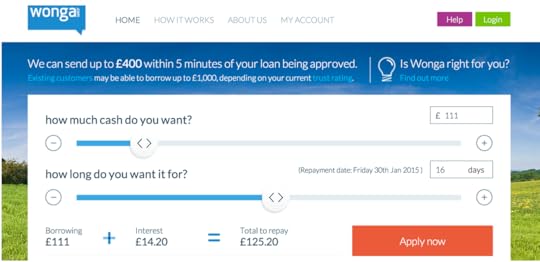
Out-thinking the competition
If you haven’t read Predatory Thinking by Dave Trott, leave this website and add it to your Amazon Wishlist. I promise it’ll be among the best books you read this year.
Without spoiling the content, the premise of his book is that, no matter how large or small you are, you can eat your competition’s market share by thinking smarter than them. While the book contains stories that can be applied to all walks of life, the concept of out-thinking the competition is extremely relevant to SEO.
One example of out-thinking your competition in SEO is to swim upstream and focus on a different portion of your market. We’ll talk more about this in the next section.
Out-working the competition
Last year I examined how six popular blogs reached over 1,000,000 monthly visitors/month in just a few years. Bear in mind, that these six blogs, including Mashable and ProBlogger, were one-man projects competing against websites with tens or hundreds of journalists.
Almost exclusively, they won by out-hustling their competitors. At one point, Pete Cashmore (founder of Mashable) was writing 7 blog posts per day, more than what most of his competitors were publishing in a week.
To out-hustle your competition in an ultra-competitive niche, you’ll need some fire in your belly and a true passion for what you’re doing. Out of the three options, it’s by far the most work.
3. Re-Focus on a Different Portion of Your Market
The majority of your competitors are likely focusing on the same small collection of keywords. One strategy for out-thinking your competitors is to swim upstream and target a different portion of market, perhaps more long tail or ‘mid tail’ focused.

Another good example of refocusing is to target an entirely different geographic market or language, if it makes sense to from a business perspective. In this post, I explained how one guy reached over 1 million visitors / month in under six months by targeting Japanese keywords, even though he couldn’t speak Japanese.
You could also consider re-focusing on a different part of the sales funnel. If everyone in your niche is focusing at the top of the sales funnel e.g. ‘what are the best online casinos?’, you could re-focus on keywords that are closer to the sign-up process e.g. ‘online casino bonuses’ to capture more converting traffic.
In Summary
When it comes to ultra-competitive SEO, you need to be beat your competitors in at least one area. Whether that’s out-smarting them, out-working them, out-spending them, or simply persisting for longer than them, you need to have enough focus on an area that you can win at.
We’ve just touched on a few potential strategies here, so I’d encourage you to think about other ways in which you can beat your competition. Hopefully this has helped spark a few ideas to get you started.
The post 3 SEO Strategies to Beat Competitors in a Competitive Niche appeared first on Venture Harbour.
January 12, 2015
A Comparison of the Best Hosted Ecommerce Platforms
If you need to setup a powerful online store quickly, choosing a hosted ecommerce platform is likely to be your best option.
The benefit of hosted platforms (over self-hosted platforms) is that most of the technical details are done for you. You won’t need to choose a web hosting company, payment processor, or worry about your site’s security.
You’ll also be able to create a beautifully-designed website by choosing a design that you like and clicking ‘install’. This means you won’t have to worry about hiring web designers or learning how to code.
So, if a hosted ecommerce platform sounds like what you’re looking for, the next question is which platform is best?
Having spent 15+ hours researching and trialing the various options, I’ve concluded that there are five platforms worth comparing, which I’ve analysed in more detail below. They are:
Shopify
BigCommerce
3dcart
Volusion
1ShoppingCart
We’ll jump straight into our review of Shopify in a moment, but in case you’re looking for a quick side-by-side comparison of these five service’s pricing, you can go straight to that section here.
1. Shopify
With over 120,000 customers, Shopify are without a doubt the most popular cloud-hosted ecommerce platform, and with good reason.
Shopify stores are beautifully designed, have strong technical infrastructure, and their platform makes setting up a professional-looking store extremely easy.

While their main product is, of course, an online store builder, Shopify also support offline selling with a point of sale (POS) system that tracks your orders and prints receipts with a nothing more than a barcode scanner, receipt printer, and iPad.
While there are a few downsides to using Shopify, it’s generally the best choice for 99% of merchants looking to sell their products online.
Let’s have a deeper look into some of the pros and cons of using Shopify.
The Good:
Beautifully designed responsive themes – Designing a Shopify store is as easy as choosing a ‘theme’ and clicking install. All Shopify themes are fully responsive, enabling them to look great on mobile and tablet devices.
Shopify Mobile App & Credit Card Reader – Shopify have their own credit card reader that plugs into your iPhone and allows you to accept credit cards on the go. The Shopify mobile app also allows you to track your sales from a mobile device, manage inventory, fulfill orders, and much more.

Surprisingly good SEO – While it does vary to some degree between themes, the quality of Shopify’s technical SEO is surprisingly good, making it easier for you to generate traffic from search engines. From little things like using microformats and rich snippet markup, to being mobile-friendly and optimised for page speed, Shopify have given store owners a head start in generating search traffic to their stores.
Optimised for speed – For ecommerce sites, any page that takes more than two seconds to load is likely harming your conversion rate. By default, Shopify stores are optimised with CDNs, Gzip compression, browser caching, and a bunch of other best practices that help your store load faster.
After testing about six different Shopify themes for page speed, I found that most loaded within 0.9 – 1.6 seconds, which is quite good.

Good security – Shopify is level-1 PCI compliant, meaning you don’t need to worry about the security of your customer’s credit card data. All transactions and credit card details are processed securely with 256-bit SSL encryption (the same level of security used by banks).
On top of this, your store is automatically backed up daily, and has several features to prevent hackers from attacking your website.
Easy to set up – While Shopify does have a bit of a learning curve, it’s easy to setup, add products, and customise without needing to learn any coding knowledge.
Marketing tools – One of my favourite features about Shopify is their focus on helping store owners market their services and generate traffic (and sales) once they’ve built their store.
From giving store owners $150 worth of Facebook Advertising & Google Adwords credit for free, to encouraging social media integration and email marketing, Shopify makes it relatively easy to start attracting potential customers and closing sales.
24/7 customer support – Another area that Shopify scores big points on is educating their customers and providing exceptional support. From their online ecommerce University, to discussion forums and 24/7 live chat, phone, and email support, you’re in good hands.
The Bad:
There aren’t many bad things to say about Shopify, though I’ve outlined a few considerations that are good to know before you become a customer.
Hard to migrate away from Shopify – If you ever decide to close your Shopify store, you’ll lose all of your data with it. Instead of allowing you to download your data or transfer it to another provider, Shopify permanently deletes all of your data when you close an account.
Price creep with third-party apps – Shopify has over 920 apps that you can use to upgrade the functionality of your Shopify store. From integrating accounting software, to setting up a reward program, these apps give you near-limitless potential to grow and customise your store.

The downside is that many of these third-party apps cost a small monthly fee, which can quickly add up to a sizeable ongoing fee.
At the same time, these apps can help you sell more products, so it’s likely that the ongoing cost of installing them would be justified by the additional revenue they generate – and if they don’t, you can just uninstall them.
Non-standard coding – If you want to make quick HTML changes to your Shopify site, you might run into a few difficulties. Shopify is based on their own language called Liquid, which means that if you want to make coding changes to your site, you might need to hire a Shopify expert who is familiar with Liquid.
Not the most affordable option – While there’s not a huge discrepancy in price, Shopify is not the cheapest hosted ecommerce platforms.
2. BigCommerce
The team behind BigCommerce have been building shopping cart software since 2003.
While the first 11 years was spent building the self-hosted ecommerce platform, Interspire, this was discontinued in 2012 to focus entirely on BigCommerce.
As of 2015, BigCommerce now hosts over 55,000 online stores that have collectively sold over $4 billion worth of products. While not as popular as Shopify, BigCommerce is still widely considered one of the best ecommerce platforms.
So, what edge does BigCommerce have over Shopify and the other platforms?
The Good:
No transaction fees on large accounts – Unlike Shopify and 1ShoppingCart, BigCommerce don’t charge transaction fees on their plans above $79.95/month. While their starter plan is relatively pricey, BigCommerce is one of the most affordable options for medium-large ecommerce websites.
Beautiful designs – In 2014, BigCommerce released a large range of modern responsive themes to choose from. Out of the five services reviewed here, these are some of the nicest looking themes to choose from.
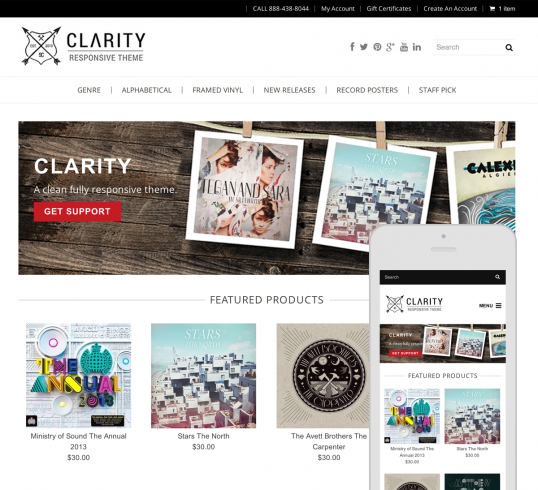
Conversion optimisation features – BigCommerce have a range of features designed to give your store the highest conversion rate possible. From a single-page optimised checkout design, to side-by-side product comparisons and recommendations, they’ve clearly put a lot of thought into helping customers squeeze the much value out of their traffic.
One of the most interesting features they offer is their abandoned cart saver, which sends a series of emails to shoppers who left their cart while shopping on your site encouraging them to come back. According their results, this converts an average of 15% of abandoned carts into sales.
SEO & multi-channel marketing – BigCommerce do an exceptional job of making their stores SEO friendly. Their themes are well-coded, fast, cross-browser compatible, fully responsive, and easy to integrate with Google Shopping, and display rich snippet markup.
BigCommerce also enable multi-channel marketing, by allowing integration with third-party sites like Ebay, Facebook, and product comparison sites.
Based on HTML & CSS – Unlike Shopify websites, which are built on Shopify’s own ruby-based language, BigCommerce websites can be customised with basic HTML and CSS, making it both easier and more affordable to make coding changes to your site.
The Bad:
Not the best customer support – After reading through several customer reviews of BigCommerce, it’s apparent that their customer support might have a few issues. While this is quite subjective and seems to have been addressed (they used to get a lot of flack for not having 24/7 support, which they began to offer in 2014), it’s something to bear in mind.
Not as many third-party apps as Shopify – The BigCommerce App Store has ~150 apps, from email marketing integrations to automatic label printing software. While this is likely to be comprehensive enough for 99% of users, it’s nowhere near as many apps as Shopify have in their app store (920).
3. 3dcart
With no transaction fees and five different pricing tiers starting at $19.99, 3dcart are one of the most affordable hosted ecommerce platforms out there.
While I wasn’t overly impressed with the quality of their store designs, 3dcart has an enormous range of features and options to customise your store.
The Good
Great pricing & no transaction fees – Apart from Volusion, 3dcart are the only other hosted ecommerce platform to not charge any transaction fees. Combined with their lower ongoing fees, this makes 3dcart one of the cheapest options out of the five.

A huge range of features – While the range of features offered by 3dcart is borderline overwhelming, it does mean that most store owners will be able to manage all of their online activity in one place. From social commerce tools to their own CRM, you’re spoilt for choice with features on 3dcart.
Very fast & lightweight – Despite using quite a lot of javascript if their templates, 3dcart templates are extremely lightweight and fast. After testing 3-4 different templates, the average loading time of a blank website was between 500ms-700ms (significantly better than Shopify’s 900 – 1600ms range).
The Bad:
Their templates need an update – While their templates aren’t bad, they’re pretty average. The majority aren’t responsive, and even their premium templates (which cost $99-199) are only just on par with many of the free themes offered by their competitors.
Unintuitive admin panel – Compared to Shopify and BigCommerce, the 3dcart admin panel feels very dated, overwhelming, and hard to navigate. With 9 navigation items that each have 5-10 sub-navigation items, it’s easy to get overwhelmed or lost while figuring out what you’re looking for.
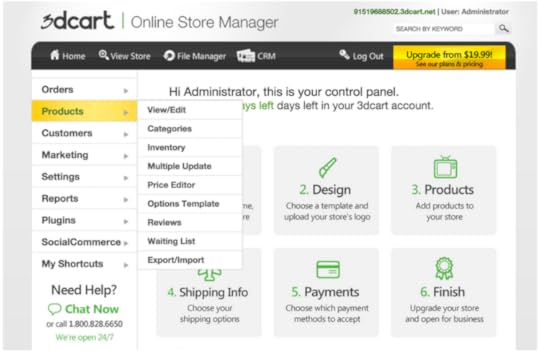
Overwhelming setup process – While it doesn’t take too long to get setup on 3dcart, their onboarding process includes nine steps, which I feel could be broken into fewer steps, or restructured to ask for information at different times.
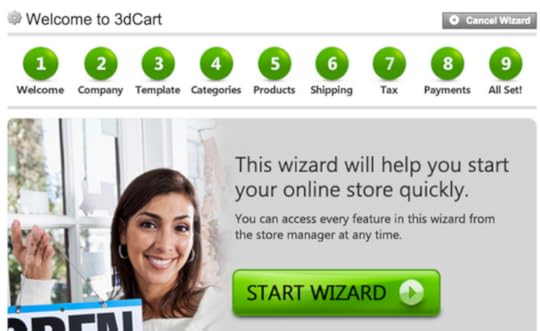
Overall, I wasn’t enormously impressed with 3dcart, but I can definitely see how they’d be a great option for people who want to manage everything in place, or who’re looking for the most affordable option.
4. Volusion
Used by companies like National Geographic and Nalgene, Volusion are another big name in the hosted ecommerce platform market worth considering.
The Good
Volusion iPhone & Android Apps – The Volusion app is beautifully-designed and gives you a quick snapshot of your inventory and sales reports. Similarly to the Shopify app, you can also process payments on the go from it. Unlike Shopify, who only have an iPhone app, Volusion also offer an app for Android users.
Beautiful ecommerce templates – The Volusion templates are extremely well-designed, and on par with those offered by BigCommerce and Shopify. As of the time of writing, there are 359 templates to choose from, ranging in price from free to $895.

No transaction fees & low payment processing fees – Thanks to a partnership with Stripe, Volusion have the the same low payment processing fees (2.15%) as Shopify. Where Volusion get a little bit more competitive is that they don’t charge any transaction fees whatsoever, so 100% of each transaction (minus the payment processing fee) is yours to keep.
Deal of the Day Feature – Urgency is one of the most powerful ways to increase a product’s conversion rate. With Volusion’s popular Deal of the Day feature you can easily run 24 hour sales to keep shoppers returning to your site and making impulse purchases.
The Bad
You need to buy an SSL certificate separately – While Volusion do seem very competitive in their pricing at first glance, they don’t include an SSL certificate, which will set you back at least $89/year. While none of the other services reviewed here provide a free SSL certificate, most do allow you to host your checkout on a secure subdomain e.g. checkout.shopify.com at no charge (allowing you to process payments securely without needing to pay for an SSL certificate).
Certain features are only available to higher-paying customers – While it’s normal for companies to unlock features for higher paying customers, Volusion only enable certain features like phone support, CRM and import/export functionality to higher-paying customers.
5. 1ShoppingCart
Created by Web.com, 1ShoppingCart is one of the most established ecommerce platforms with over 3 million customers.
As given away by their name, 1ShoppingCart is primarily a shopping cart. Combined with the webs.com website builder and a few other features – like email autoresponders, an affiliate program builder, and a basic CRM, 1ShoppingCart has become a relatively powerful hosted ecommerce platform.
While their website and service isn’t quite as slick as competitors like Shopify, their track record definitely earns them a spot in any comparison of the best ecommerce platforms.
So what are the pros and cons of 1ShoppingCart?
The Good
Cross-sells & Post-sale upsells – 1ShoppingCart makes it easy to cross-sells related products and add up-sells on your cart and checkout pages, boosting your average transaction value.
Affiliate management – One area that 1ShoppingCart does extremely well is enable you to manage a powerful affiliate program. With discount codes, coupons, and integration with your email autoresponders, you can easily incentivise affiliates to promote your products for you.
The Bad
Mediocre Designs – Similarly to 3dcart, their store template aren’t bad but they’re just not what you’d expect to see from a modern ecommerce site in 2015. To give them credit, their templates are responsive, and have clearly been built with conversion optimisation in mind.
Expensive – 1ShoppingCart is the most expensive hosted ecommerce platform out of all those we’ve reviewed. With a starter package that costs over twice as much as Shopify’s similar basic package, and a $249/month fee for their ultimate package, 1ShoppingCart clearly doesn’t compete on price. On top of this, their transaction and payment processing fees are also quite steep relative to the others.
Comparing the Price of Different Hosted Ecommerce Platforms
There are three main costs to take into account when choosing a hosted ecommerce platform: the ongoing monthly account fee, the transaction fee, and the payment processing fees.
Payment processing fees are what you pay to a company like PayPal or Stripe for being able to accept a customer’s credit card payment. The transaction fee is a percentage of each sale that the ecommerce platform takes out of each sale you make.
While payment processing fees are fairly consistent across the board (2.1 – 2.9% per transaction), monthly account fees and transaction fees vary a lot.
As most ecommerce platforms have tiered pricing, I’ve compared the prices of each service for a range of different stores sizes below to give you an idea of how much each service would likely cost.
Price for a tiny online store (low traffic, under 25 products)
Shopify – $14/month + no transaction fees + 2.15% payment processing fee
BigCommerce – $29.95/month + 1.5% transaction fees + 2.9% payment processing fee
3dCart – $19.99/month + 0% transaction fees + 2.9% payment processing fee
Volusion – $15/month + 0% transaction fees + 2.15% payment processing fee
1ShoppingCart – $34/month + 1.25% transaction fees + 2.85% payment processing fee
Price for a small online store (low traffic, up to 200 products)
Shopify – $29/month + 2% transaction fees + 2.15% payment processing fee
BigCommerce – $29.95/month + 1.5% transaction fees + 2.9% payment processing fee
3dcart – $35.99/month + 0% transaction fees + 2.9% payment processing fee
Volusion – $35/month + 0% transaction fees + 2.15% payment processing fee
1ShoppingCart – $34/month + 1.25% transaction fees + 2.85% payment processing fee
Price for mid-sized online store (10k monthly visitors, unlimited products)
Shopify – $79/month + 1% transaction fees + 2.15% payment processing fee
BigCommerce – $79.95/month + 0% transaction fees + 2.9% payment processing fee
3dcart – $99.99/month + 0% transaction fees + 2.9% payment processing fee
Volusion – $75/month + 0% transaction fees + 2.15% payment processing fee
1ShoppingCart – $119/month + 1% transaction fees + 2.85% payment processing fee
Price for a large online store (high traffic, unlimited products, advanced features)
Shopify – $179/month + 0.5% transaction fees + 2.15% payment processing fee
BigCommerce – $199/month + 0% transaction fees + 2.9% payment processing fee
3dcart – $129.99/month + 0% transaction fees + 2.9% payment processing fee
Volusion – $135/month + 0% transaction fees + 2.15% payment processing fee
1ShoppingCart – $249/month + 0.75% transaction fees + 2.85% payment processing fee
Summary
There is no ‘one-size fits all’ hosted ecommerce platform. The best platform for you will depend on your budget, and specific feature requirements.
For brick-and-mortor businesses who want to build an online presence, Shopify are likely to be the best option, due to their POS system and excellent infrastructure around mobile payments.
If you’re on a tight budget, 3dcart will likely be the most cost effective option over the long run, particularly when you take into account their lack of transaction fees.
While I hope this comparison has helped you narrow down the options, I do recommend setting up a free trial account with two or three different options and finding out for yourself which platforms are the best fit for you.
Full Disclaimer: I’ve not personally used all of the services reviewed in this post beyond their free trials. While I did spend quite a lot of time setting up mock sites and running my own tests, some of the information in this post is based on previous customer reviews and claims from the service’s websites.
Also, some of the links in this post are affiliate links, which means we receive a small commission if you decide to sign up with a service through our link. It doesn’t cost anything extra to you, and it helps us to justify spending 15+ hours researching and writing in-depth posts like this one, that will hopefully save others from having to doing the same.
The post A Comparison of the Best Hosted Ecommerce Platforms appeared first on Venture Harbour.
January 11, 2015
A Review of Ontraport
I first heard about Ontraport a few years ago from some friends at Mindvalley.
According to a testimonial by their founder Vishen, Mindvalley’s COO spent six months comparing delivery rates, open rates, and the general performance of Ontraport against all of their major competitors, and Ontraport came out on top.
In August last year, I ran my own analysis comparing Ontraport (previously Office Autopilot) against Infusionsoft, Marketo, Pardot, Hubspot, and Eloqua. Out of the five, Ontraport was the only tool to score a 5/5 review.
Like all software, Ontraport is not perfect, and there are many things that their competitors do infinitely better. When looked at from a birds-eye view, though, Ontraport is one of the best marketing automation solutions available to fast-growing online businesses.
So, let’s jump straight into the pros and cons of Ontraport, starting with their strengths.
The Good
The most affordable marketing automation system – One of the most obvious benefits of Ontraport is their pricing. Their pro plan starts at $297/month and has no additional setup fees. In contrast with Infusionsoft, who charge a mandatory $1,999 kickstart fee, this makes Ontraport quite attractive financially.
Ontraport is particularly affordable for companies that have enormous mailing lists or who send a large number of emails. While Infusionsoft charge $379/month for 10,000 database contacts and 50,000 email credits, Ontraport allows you to have over twice as many contacts and email credits for just $297/month.
You can see a comparison of Ontraport and Infusionsoft’s pricing below:

Highly scalable & less price creep than competitors – One of the most common criticisms of marketing automation tools is their price creep. Going from 1,000 contacts to 10,000 contacts on Hubspot, for example, will increase your monthly fee from $800/month to $2,400/month.
With Ontraport, the fees for adding extra users, contacts, and email credits are significantly less than some of their competitors, which makes it easier and more affordable to grow your list size and automation sequences.
What’s also particularly nice about Ontraport’s pricing is that you only need to pay for what you need. Instead of having to upgrade to the next tier, you can just pay an extra $99/month for 100,000 extra email credits, or $47/month for an extra user.
A huge range of good features – With Ontraport, you get a CRM, shopping cart, affiliate management tool, landing page / micro site creator, auto-responders, a WordPress membership platform, online event / webinar creator, and task automation for a few hundred dollars per month.
To get this level of functionality in Infusionsoft, you’d need to buy quite a few add-ons.
Usually when a company offers a list of features like this, you might suspect that some of them are just going to be bells and whistles. This isn’t the case with Ontraport – all of their features are actually quite good.
What’s also particularly nice is that, unlike Infusionsoft and Hubspot who ‘unlock’ more features as upgarde your plan, you get access to the whole suite of Ontraport features, whether you’re on their pro or team plan.
True multi-channel marketing – One of my favourite aspects of Ontraport is the ability to automate sequences across multiple marketing channels. You can, for instance, communicate with leads via 2-way text message, or even by posting them a postcard.

This ability to communicate not only across social platforms and via email, but also outside of the online world is a huge selling point for Ontraport, as it gives companies an opportunity to stand out from the crowd and reach leads / customers where there’s less noise to compete with.
Great email delivery rates – Ontraport have their own dedicated IP addresses for sending emails, which have very high sender reputations, enabling you to avoid the spam box and get great email delivery rates.
Highly-segmented reporting – With Ontraport, everything is tracked using UTM variables, making it easy for you to know your CPA, customer lifetime value, and which lead sources or content campaigns are generating the best ROI.
Great customer support – While I don’t have any first-hand experience with Ontraport’s customer support, it’s evident from the hundreds of positive reviews that their support team are both technically knowledgeable and helpful in educating customers.
On top of their standard support, Ontraport run their own annual conference and have a good amount of educational content to ensure that customers get the most out of their software.
Mobile apps – At the 2014 Ontrapalooza (Ontraport’s annual conference), Ontraport announced the launch of both an iPhone and Android app that allows you to manage your CRM, add new contacts, and subscribe users to your sequences.

While you can’t review reports or do anything too in-depth, the apps are useful for keeping your contacts up to date and sending quick messages (either via email or text) to different groups.
Powerful shopping cart features – From automated credit card payment collections, to upsells and pre-made sequences designed to reduce money lost from abandoned cart payments, the Ontraport shopping cart has a lot of powerful features to reduce friction and boost conversion rates.
The Bad & The Ugly
Not the most inspiring dashboard – While it is completely customisable, the Ontraport dashboard isn’t particularly inspiring or visually intuitive. As shown below, the main dashboard displays a table of boxes that show whatever metrics are most important to you.

Steep learning curve – It can take weeks and months to fully understand what you can do in Ontraport. While their software does have a steep learning curve, it’s good to remember that this is the case with all marketing automation tools.
The impact that Ontraport can have on growing a business almost certainly makes the steep learning curve worth the effort, but there are areas where I think Ontraport could make the software a little bit easier to learn.
Sequence creation isn’t as intuitive as competitors – One of the most powerful features of Ontraport is the ability to create automated sequences that are triggered when leads complete a certain action. While their sequence creator is powerful, it’s not quite as intuitive or fun to use as some of Ontraport’s competitors.
Below is a comparison of Ontraport’s sequence editor next to the Infusionsoft sequence editor.

Not many integrations – While Ontraport do have an API and 24 partner integrations, their infrastructure for third-party apps is nowhere near as extensive as Infusionsoft, who at the time of writing have 348 apps and integrations in their marketplace.
Ontraport’s integrations include most of the common services, like Quickbooks, WordPress, PayPal, 1ShoppingCart, and LeadPages. But with only 24 integrations you’re obviously a little bit limited, unless your developers are able to play around with the API.
No online community – For such a powerful and complex tool, it’s surprising that Ontraport don’t have an online community for Ontraport users to share tips, strategies, and case studies. While this is also a feature lacking among most marketing automation tools, I think it’d be a great addition to their service.
Duplicate records – Ontraport don’t make it easy to clean up your records and remove duplicate contacts. If one user downloads an eBook from your site, attends a webinar, and buys a product, they can end up being added to your database three times. While this wouldn’t be an issue if Ontraport had an easy way to remove duplicates, they don’t.
In Summary: Who is Ontraport best for?
If you sell information products, run a membership site, or have any kind of online training or education company, Ontraport is easily the best marketing tool for you.
While Infusionsoft is definitely worth looking at, Ontraport is a bit more affordable and has a lot more features that’ll get you up and running in less time.
Ontraport don’t have a free trial, unfortunately, but they do have a free demo that you can sign up for here. They also have a 90-day money back guarantee (with no setup or cancellation costs), so worst case scenario you can always cancel your account within the first three months and get your money back.
The post A Review of Ontraport appeared first on Venture Harbour.
January 8, 2015
5 Best B2B Lead Generation Strategies (That Actually Work)
When it comes to B2B lead generation, what really impacts the bottom line?
In this post, we’re going to talk about how one health-tech company generated a 5,100% ROI from a $1 million integrated online marketing campaign. We’ll also look at how a major accounting firm generated $1.3 billion in pipeline revenue from content marketing.
But before we jump into the case studies and discuss specific strategies, let’s find out which lead generation strategies are actually driving the best results for B2B marketers.
Which B2B Lead Generation Strategies Work?
The answer to this question depends on who you ask.
If we were to go by Hubspot’s study of the best B2B lead sources, we’d conclude that SEO is the best (identifiable) lead generation channel.

If, on the other hand, we used Chief Marketer’s data on the same question, we’d conclude that email marketing is the most effective channel for B2B lead generation. Needless to say, there are similar surveys reporting that social media and content marketing are also the most effective forms of B2B lead generation.
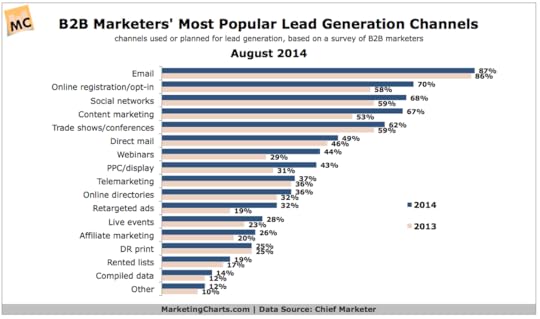
Why so much variation?
The likely answer is to do with audience biases. A survey conducted by an email marketing provider is almost certainly going to have different results to one conducted by PPC management tool, as their audiences have different skillsets and biases, skewing the results of their sample. As such, we should take the specific ranking of different strategies in these studies with a pinch of salt.
Inconsistencies aside, the online strategies that consistently come out at the top are:
Email marketing
Search marketing
Social marketing
Content marketing
We’ll look at each these in more depth in a moment, but bear in mind that how you use a lead generation channel is more important than what lead channel you choose.
Twitter can be used to close a $250,000 lead for a B2B business, or it can be used to spam potential leads and tarnish a brand. So, while the channel/strategy you choose will play a large role in how effective your lead generation is, how you execute your campaign will play an even bigger role.
With this caveat out the way, let’s look at some of the ways that B2B companies are using the four strategies listed above to generate impressive results.
5 Ways to Generate B2B Leads Online
In this section, we’ll cover the four strategies outlined above, as well as a strategy that hasn’t been mentioned in any of the studies, yet it enabled one B2B company to generate a 5,100% ROI from a $1 million investment.
First though, let’s talk about one of the oldest strategies in online marketing: email marketing.
1. Email Marketing
Email marketing is one of the few online marketing channels that has stood the test of time. In fact, email is 23 years old this year, and it still trumps the top spot on many B2B marketer’s lists of B2B lead generation strategies.
One of the biggest trends in email marketing at the moment, that has generated great results for many B2B businesses, is marketing automation.
Not sure what the fuss about marketing automation is? Read this. In short, marketing automation tools are effectively hybrid email marketing tools that connect with your CRM to enable you to automatically send highly targeted emails to leads that are personalised specifically to them.
When Thomson Reuters upgraded to a marketing automation solution, their revenue increased by 172%. Another company increased their revenue by 832% (going from $80,000 in debt to $2 million in revenue) in just three years.
While traditional newsletters and email marketing are still important, the ability to capture more data on users and use behavioural-triggers has enabled B2B marketers to get a lot smarter with how they target users in the inbox.
2. Content Marketing: From Blogging to Microsites
By creating a total of 48 infographics, videos, and Q&A blog posts targeting C-level prospects of large market cap financial institutions, the public accounting firm Crowe Horwath generated $250,000 in revenue attributed to content marketing.
If 6-figure growth doesn’t get you excited, perhaps 10-figures (a billion) will.
In 2012, Xerox created a microsite offering relevant tips to business owners. The result? 70% of the companies targeted interacted with the microsite, adding 20,000 new contacts to their pipeline, 1,000+ of which scheduled appointments. The value of those appointments exceeded $1.3 billion in pipeline revenue.
Given the broad scope of content marketing, a good question to ask is what type of content should B2B companies be focusing on to generate leads?
Well, you could go by which tactics are most commonly used by other B2B companies (displayed below). The risk of this approach is that, by definition, you’ll be doing what everyone else is doing.
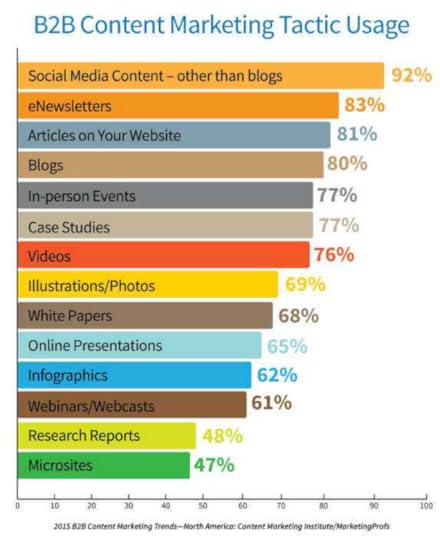
While there is some wisdom in following trends, there’s a good argument to do exactly the opposite of what other marketers are focusing on.
“Whenever you find yourself on the side of the majority, it is time to pause and reflect.” – Mark Twain
Whether you’re a contrarian marketer or prefer to stick to what’s working for others, a good content marketing strategy requires a degree of diversity and experimentation to understand where the biggest growth opportunities are for your business.
So, by all means, experiment with the common and uncommon tactics. Whether you use microsites, blogging, research reports, or infographics, the important thing is to test what does and doesn’t work so that you can gradually refine your lead generation over time.
3. Search Marketing
Organic search marketing is arguably one of the most valuable long-term strategies for generating B2B leads.
About 5-6 years ago, I was working on the SEO campaign for a major business stationery brand. It was one of my first ‘big campaigns’ that I was allowed to manage in my previous job.
While I can’t take the credit (their in-house SEO team and previous agencies had laid a great foundation for us), I watched the site’s revenue from SEO increase by over £4 million, just from a handful of keywords reaching #1 on Google.
Getting to #1 in Google is a lot harder today than it was five or ten years ago, and it can barely be summarised in a few sentences.
If I were to attempt it, though, I’d probably say that good SEO in 2015 is largely a bi-product of doing things well in other areas e.g. design, conversion rate optimisation, content marketing, and social. While there are exceptions, this is increasingly looking like the rule.
4. Social Media
Calling social media an effective B2B lead generation strategy is a controversial discussion to be starting.
While social media scored very well on both of the aforementioned ‘studies’, we can just as easily find reports where social media channels are regarded as the least effective lead generation strategies.
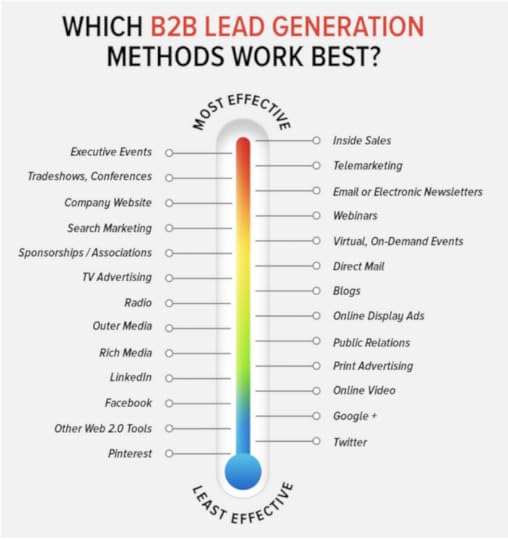
The bottom line is, social media isn’t inherently a poor channel for B2B lead generation. The reason social media is sometimes rated poorly on these aggregate studies is because most B2B companies have an ill-fitting social media strategy, to put it politely.
While tens of thousands of companies blast out self-promotional drivel, a minority of businesses use it generate and nurture millions of dollars worth of leads. In this instance, it’s best to learn from the minority rather than the majority.
One of the most obvious ways to generate B2B leads from social media is using LinkedIn. An commodity risk management company managed to generate over $2 million in pipeline value through their lead generation strategy.
Another consideration is that social media is an integral part of content marketing, and to some extent, search marketing. How successful will your blogging or infographics be if no one’s following your company’s updates on social media?
5. Integrating it all together
It’s said that success leaves clues. Well, when a $37 billion company generates a 5,100% return on investment on a million-dollar marketing campaign, it might be a pretty good clue.
From a $1 million investment in an integrated marketing campaign that included display ads, email marketing, campaign websites and content marketing, the healthcare technology company Optum generated $52 million in new business.
So, what’s the clue?
I believe it’s this: exceptional lead generation results come from a relentless willingness to experiment with different tactics, and to combine tactics across multiple channels.
Only by experimenting, can you truly know what does and doesn’t work, and when you know this, you can use your time and budget more effectively to generate higher returns on your investment, and better lead generation results overall.
I hope this post has given you some inspiration on what’s possible with B2B lead generation, and which areas are best to focus on. As always if you have any questions, or are interested in getting touch, feel free to comment below or drop me an email here.
The post 5 Best B2B Lead Generation Strategies (That Actually Work) appeared first on Venture Harbour.
Which Are the Best B2B Lead Generation Strategies?
When it comes to B2B lead generation, what really impacts the bottom line?
In this post, we’re going to talk about how one health-tech company generated a 5,100% ROI from a $1 million integrated online marketing campaign. We’ll also look at how a major accounting firm generated $1.3 billion in pipeline revenue from content marketing.
But before we jump into the case studies and discuss specific strategies, let’s find out which lead generation strategies are actually driving the best results for B2B marketers.
Which B2B Lead Generation Strategies Work?
The answer to this question depends on who you ask.
If we were to go by Hubspot’s study of the best B2B lead sources, we’d conclude that SEO is the best (identifiable) lead generation channel.

If, on the other hand, we used Chief Marketer’s data on the same question, we’d conclude that email marketing is the most effective channel for B2B lead generation. Needless to say, there are similar surveys reporting that social media and content marketing are also the most effective forms of B2B lead generation.

Why so much variation?
The likely answer is to do with audience biases. A survey conducted by an email marketing provider is almost certainly going to have different results to one conducted by PPC management tool, as their audiences have different skillsets and biases, skewing the results of their sample. As such, we should take the specific ranking of different strategies in these studies with a pinch of salt.
Inconsistencies aside, the online strategies that consistently come out at the top are:
Email marketing
Search marketing
Social marketing
Content marketing
We’ll look at each these in more depth in a moment, but bear in mind that how you use a lead generation channel is more important than what lead channel you choose.
Twitter can be used to close a $250,000 lead for a B2B business, or it can be used to spam potential leads and tarnish a brand. So, while the channel/strategy you choose will play a large role in how effective your lead generation is, how you execute your campaign will play an even bigger role.
With this caveat out the way, let’s look at some of the ways that B2B companies are using the four strategies listed above to generate impressive results.
5 Ways to Generate B2B Leads Online
In this section, we’ll cover the four strategies outlined above, as well as a strategy that hasn’t been mentioned in any of the studies, yet it enabled one B2B company to generate a 5,100% ROI from a $1 million investment.
First though, let’s talk about one of the oldest strategies in online marketing: email marketing.
1. Email Marketing
Email marketing is one of the few online marketing channels that has stood the test of time. In fact, email is 23 years old this year, and it still trumps the top spot on many B2B marketer’s lists of B2B lead generation strategies.
One of the biggest trends in email marketing at the moment, that has generated great results for many B2B businesses, is marketing automation.
Not sure what the fuss about marketing automation is? Read this. In short, marketing automation tools are effectively hybrid email marketing tools that connect with your CRM to enable you to automatically send highly targeted emails to leads that are personalised specifically to them.
When Thomson Reuters upgraded to a marketing automation solution, their revenue increased by 172%. Another company increased their revenue by 832% (going from $80,000 in debt to $2 million in revenue) in just three years.
While traditional newsletters and email marketing are still important, the ability to capture more data on users and use behavioural-triggers has enabled B2B marketers to get a lot smarter with how they target users in the inbox.
2. Content Marketing: From Blogging to Microsites
By creating a total of 48 infographics, videos, and Q&A blog posts targeting C-level prospects of large market cap financial institutions, the public accounting firm Crowe Horwath generated $250,000 in revenue attributed to content marketing.
If 6-figure growth doesn’t get you excited, perhaps 10-figures (a billion) will.
In 2012, Xerox created a microsite offering relevant tips to business owners. The result? 70% of the companies targeted interacted with the microsite, adding 20,000 new contacts to their pipeline, 1,000+ of which scheduled appointments. The value of those appointments exceeded $1.3 billion in pipeline revenue.
Given the broad scope of content marketing, a good question to ask is what type of content should B2B companies be focusing on to generate leads?
Well, you could go by which tactics are most commonly used by other B2B companies (displayed below). The risk of this approach is that, by definition, you’ll be doing what everyone else is doing.

While there is some wisdom in following trends, there’s a good argument to do exactly the opposite of what other marketers are focusing on.
“Whenever you find yourself on the side of the majority, it is time to pause and reflect.” – Mark Twain
Whether you’re a contrarian marketer or prefer to stick to what’s working for others, a good content marketing strategy requires a degree of diversity and experimentation to understand where the biggest growth opportunities are for your business.
So, by all means, experiment with the common and uncommon tactics. Whether you use microsites, blogging, research reports, or infographics, the important thing is to test what does and doesn’t work so that you can gradually refine your lead generation over time.
3. Search Marketing
Organic search marketing is arguably one of the most valuable long-term strategies for generating B2B leads.
About 5-6 years ago, I was working on the SEO campaign for a major business stationery brand. It was one of my first ‘big campaigns’ that I was allowed to manage in my previous job.
While I can’t take the credit (their in-house SEO team and previous agencies had laid a great foundation for us), I watched the site’s revenue from SEO increase by over £4 million, just from a handful of keywords reaching #1 on Google.
Getting to #1 in Google is a lot harder today than it was five or ten years ago, and it can barely be summarised in a few sentences.
If I were to attempt it, though, I’d probably say that good SEO in 2015 is largely a bi-product of doing things well in other areas e.g. design, conversion rate optimisation, content marketing, and social. While there are exceptions, this is increasingly looking like the rule.
4. Social Media
Calling social media an effective B2B lead generation strategy is a controversial discussion to be starting.
While social media scored very well on both of the aforementioned ‘studies’, we can just as easily find reports where social media channels are regarded as the least effective lead generation strategies.

The bottom line is, social media isn’t inherently a poor channel for B2B lead generation. The reason social media is sometimes rated poorly on these aggregate studies is because most B2B companies have an ill-fitting social media strategy, to put it politely.
While tens of thousands of companies blast out self-promotional drivel, a minority of businesses use it generate and nurture millions of dollars worth of leads. In this instance, it’s best to learn from the minority rather than the majority.
One of the most obvious ways to generate B2B leads from social media is using LinkedIn. An commodity risk management company managed to generate over $2 million in pipeline value through their lead generation strategy.
Another consideration is that social media is an integral part of content marketing, and to some extent, search marketing. How successful will your blogging or infographics be if no one’s following your company’s updates on social media?
5. Integrating it all together
It’s said that success leaves clues. Well, when a $37 billion company generates a 5,100% return on investment on a million-dollar marketing campaign, it might be a pretty good clue.
From a $1 million investment in an integrated marketing campaign that included display ads, email marketing, campaign websites and content marketing, the healthcare technology company Optum generated $52 million in new business.
So, what’s the clue?
I believe it’s this: exceptional lead generation results come from a relentless willingness to experiment with different tactics, and to combine tactics across multiple channels.
Only by experimenting, can you truly know what does and doesn’t work, and when you know this, you can use your time and budget more effectively to generate higher returns on your investment, and better lead generation results overall.
I hope this post has given you some inspiration on what’s possible with B2B lead generation, and which areas are best to focus on. As always if you have any questions, or are interested in getting touch, feel free to comment below or drop me an email here.
The post Which Are the Best B2B Lead Generation Strategies? appeared first on Venture Harbour.





